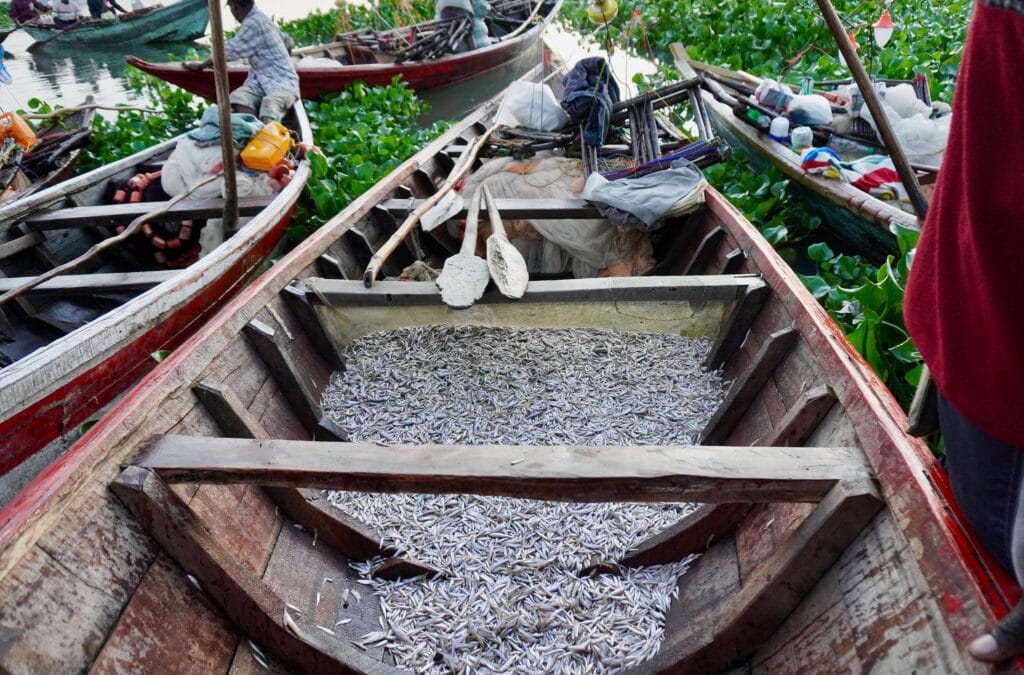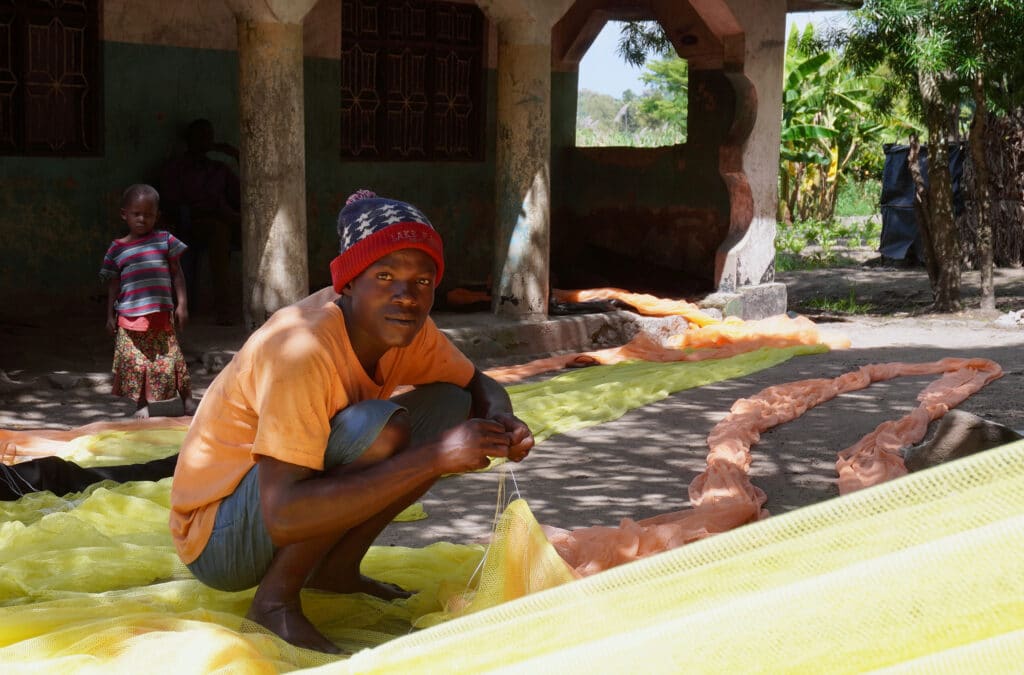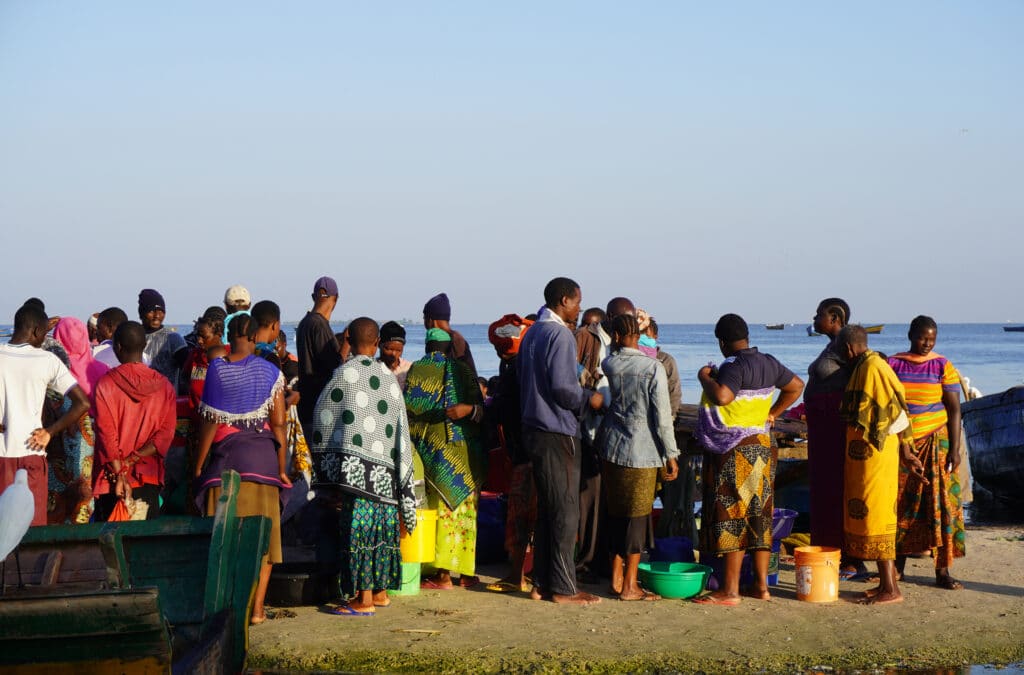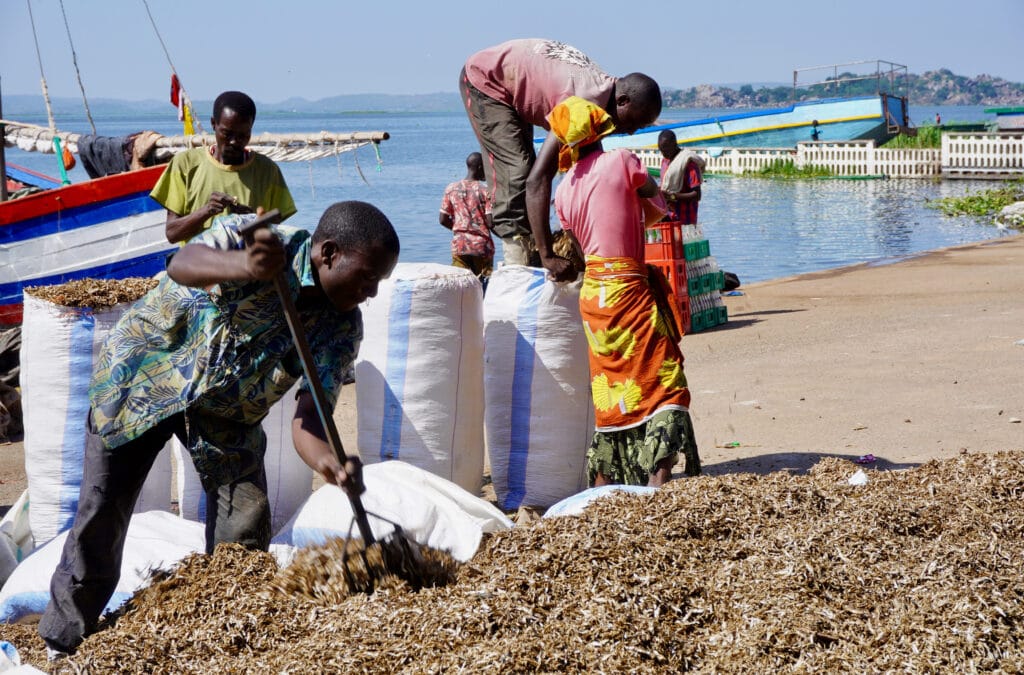The true value of Lake Victoria’s smallest fish
24-03-20
Read the story Meet Lake Victoria’s tiniest fish 2 May 2020 in The East African
The Danida supported research project “Innovations and Markets for Lake Victoria Fisheries” is winding up with two completed master’s, five completed PhDs, two postdocs, new dissemination and communication methods and – most important of all – findings relevant for both the local fishing communities and national policies in Tanzania.
By Vibeke Quaade, Mwanza in Tanzania
It is early morning in Mwanza, a major fishing town in Tanzania on the shores of Lake Victoria. The sun is about to come up and the roads are already busy with traffic heading towards the lake’s landing sites, mostly groups of women, chatting and carrying empty buckets, but also motorbikes and some cars and lorries. There they will meet the fishing boats that are on their way back after a long night on the lake. They will buy what they need from the heaps of newly caught sardines, load their buckets and cars and spend the rest of the day processing the fish before selling it at the market.

Igombe landingsite. Mwanza, Tanzania. Photo: Vibeke Quaade
Robinson Mdegela, Professor of Fish Medicine and Aquatic Toxicology at Sokoine University of Agriculture (SUA) in Morogoro, Tanzania, observes the bustling scene and explains,
The sardine is the lake’s smallest fish, but it plays a major role in people’s lives and it shows. The crack of dawn is always the busiest time of day in the lake regions.
Robinson Mdegela is in Mwanza as one of a team of researchers from Tanzanian and Danish universities. They have been working on the research project “Innovations and Markets for Lake Victoria Fisheries” (IMLAF) for the past five years.
Sardines for socio-economic growth
He explains that the objective of the project is to catalyse and facilitate socio-economic growth through the expansion of markets for quality sardine products and employment opportunities.

Luchelele, Mwanza, Tanzania. Photo: Vibeke Quaade
The small sardine already makes up 72 percent of the lake’s total landings. It is only about 10 mm long but it breeds six to seven times a year and the volume of landings keeps on increasing. Of the three countries (Tanzania, Kenya and Uganda) bordering the lake, Tanzania is the main contributor to this increase, having landed 433,845 tons of sardines in 2015 as compared with 289,873 tons in 2010. About ten years ago, the three countries faced a situation where there was extensive piracy and potential overfishing. The governments put preventive measures in place such as coast guard patrols and mesh size regulations. The mesh size must not be below 8 mm.
Nevertheless, the volume of landed sardines increases year by year, as does market demand, nationally and in the region. In light of both Tanzania’s national growth strategies and the unemployment and poverty levels in the fishing communities, the significance of sardine fishing cannot be overlooked.
The potential of using the small fish for the benefit of the communities and the country is obvious, Robinson Mdegela says.
Too many good fish go to waste
However, this is easier said than done as there are various challenges involved. One of them is that up to 80 percent of the sardine landings is lost in postharvest processing. Sometimes these figures are even higher in the rainy season and may reach 100 percent.

Igombe landingsite. Mwanza, Tanzania. Photo: Vibeke Quaade
Robinson Mdegela gazes at the sky. It is the middle of the rainy season and the chance of showers in the afternoon is quite high.
One shower can wash away a whole night and day’s work, he says.
In addition, more than 80 percent of the current end products is of a quality that is only suitable for animal feed and not for human consumption.
Lifting the entire sector to a new level
The research project “Innovations and Markets for Lake Victoria Fisheries” has therefore examined various methods that could reduce postharvest losses, increase the quality of processed fish and thereby contribute to lifting the entire sector to a higher level.
After five years of research, the project is now in its final stages and Robinson Mdegela and the other researchers are in Mwanza to discuss their findings with a group of stakeholders from the fishing industry, local government and the Ministry of Livestock and Fisheries. The stakeholders have already met with the researchers several times to give their input to the project. At this final meeting, their role is to contribute to the project’s policy recommendations. They soon zoom in on two areas they find suitable to take to policy level. The first is the research project’s advice on renewing the sector’s business model. The second is about modernizing postharvest techniques.
Renewed business model
Josephine Joseph Mkunda, Lecturer at the Nelson Mandela African Institute of Science and Technology, has led the project’s examination of the supply chains and market mechanisms.

Igombe landingsite. Mwanza, Tanzania. Photo: Vibeke Quaade
According to her, the main barrier for the development of the sardine industry is that capital invested in fishing activities may well be detrimental to subsistence fishing.
The existing business models are inefficient and imperfectly competitive. They favour a minority in the fishing industry at the expense of the majority who can barely uphold a sustainable livelihood anyway. This is very unfortunate, because in effect it holds back the entire industry, Josephine Joseph Mkunda explained.
Making the supply chain stronger
Her suggestion is a new model where the different actors in the sector, from processors, to traders and exporters, get together in cooperatives or form innovative collaborative platforms. Such professional group formations would make it easier for anyone in the supply chain to keep informed about market dynamics and prices and to share knowledge about fishing and processing techniques. It would also make it easier to obtain loans for investments, loans that are virtually impossible to obtain, if you are an individual fisherman or processor.
Only if the fishermen, processors, traders and transporters collaborate will they have a chance to realize economies of scale, Josephine Joseph Mkunda said.

Luchelele, Mwanza, Tanzania. Photo: Vibeke Quaade
The stakeholders salute her, as one of the entrepreneurs and sardine processors, Peter Balyagati, says.
A chain is only as strong as its weakest part. The way to make this industry take off for real is to strengthen the first parts of the supply chain. We’ve got nothing to lose.
Modernised processing techniques
The other finding that the stakeholders have agreed on as an important issue for a policy recommendation concerns the current postharvest techniques.
Traditionally, it is mostly women who process the sardines. They dry the sardines directly on rocks, sand or old nets spread out on the grass or beach. The result is that the dried product often contains bits of sand and grass and as a result is of substandard quality and only suitable for animal feed.

Igombe landingsite. Mwanza, Tanzania. Photo: Vibeke Quaade
A few processors dry their sardines on raised racks, but generally drying racks have not caught on, and neither has salting nor smoking.
Greenhouse drying
Dr Davis Chaula, Lecturer at Sokoine University of Agriculture has looked into how greenhouse-drying techniques could reduce postharvest loss and also improve product quality. During his research, he experimented with ventilated greenhouses in which trays of sardines are placed on shelves that are raised off the ground.
Greenhouse drying is especially recommendable during the rainy season to prevent losses, Davis Chaula said.
Besides securing a drying process undisrupted by rains and a sand and grass free product, Davis Chaula’s findings also showed that greenhouse drying may minimize nutrient loss as compared with open sun drying.
Agnely Adriana Lushsha, Fisheries Officer at the Ministry of Livestock and Fisheries was particularly interested in the drying techniques.
These findings give us knowledge on how to partially solve some of the issues in postharvest loss at artisan level, which we all can agree are way too extensive, particularly in the rainy season, he said, adding that alternative drying methods for industrial processing were needed too.
Media outreach and ripple effects
The day is coming to an end, and along the lakeside the fishermen are starting to prepare themselves and their fishing gear for another night’s work. While some are carrying the fishing nets and the pressure lamps, that they use to attract the small fish, down to the shore, others are preparing the boats. The men take off in teams of four, each with a specific role to play in the current business model, as is the case with everyone else in the sector.

Mwaloni Market, Mwanza, Tanzania. Photo: Vibeke Quaade
It is a very tradition based industry and changing the status quo of the current working patterns cannot be done overnight. One thing is to come up with new methods, another is to communicate these methods and effect change, says Robinson Mdegela, who is proud that the research team has also taken the first steps to meet this task.
Originally, the dissemination plans were based on a training of trainers’ approach, where 1,000 sardine processors were to be trained. After having held consultations with the involved universities and participating in the communications training seminar Bridging the Gap arranged by Danida Fellowship Centre and COSTECH, the team changed their dissemination tactics, deciding to make them media oriented.
I think this approach has had a greater effect than we would have gotten from our original plans, Robinson Mdegela says. He explained that the team has produced two vidoes in collaboration with Tanzania’s AZAM media and that these videos have led to several radio appearances and large numbers of inquiries from members of the community, local authorities and the media.
Five completed PhDs, two master’s and two postdocs
The project is also winding up with five completed PhDs and two master’s. Robinson Mdegela is pleased with the achievements.
We set out to find solutions to postharvest and quality losses because we wanted to find a way to use the potential of the small fish for the benefit of the communities and the country.
I think we have made progress on both fronts.

University partners: Sokoine University of Agriculture, Nelson Mandela African Institution of Science and Technology in Tanzania, the Technical University of Denmark and University of Copenhagen. Photo: Hylding.
Go back to our stories